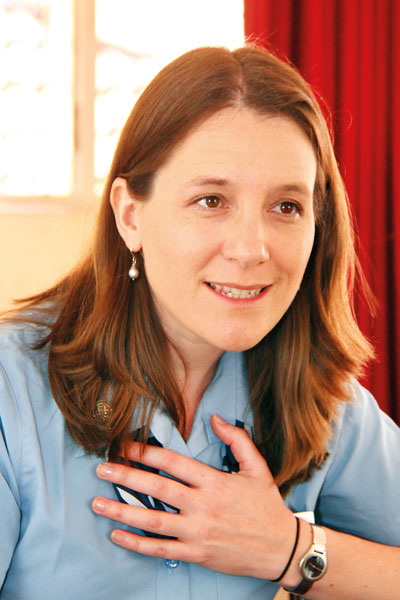A century on, a new world of Guiding

Nicola Grinstead
In 1917, the first Girl Guide Company was formed at Girls’ High School Kandy, a mere seven years after the movement had been initiated in the UK by Lord Baden-Powell. Since then Guiding has spread throughout the island and made a lasting impact on society.
On March 25, over 6000 girls and young women from all over the island came together for the centennial celebration of the Girl Guides Movement in Sri Lanka, in the city of its birth, Kandy.
Nicola Grinstead, Chair of the World Board of the World Association of Girl Guides and Girl Scouts (WAGGGS), was in Sri Lanka for this important milestone and spoke to the Sunday Times about the future of the Guide movement both in Sri Lanka and globally.
“WAGGGS exists because the world we have is not the world we want for girls,” she says emphatically. Girls and young women today face a variety of social issues, from economic disparity and gender-based violence, to body confidence issues and body shaming. “These issues prevent women from reaching their full potential and thriving in society. Society doesn’t work unless every member of it can thrive and fulfil their own potential,” says Nicola. But despite facing these issues it is uplifting to see that women themselves can combat it and be the solutions to these problems, she notes.
WAGGGS has initiated two global projects to combat these issues faced by women. The first project ‘Voices against Violence’, is done in partnership with the UN women in order to combat gender based violence. The project arms young people with the necessary tools and expertise to understand the root causes of gender-based violence, prevent such violence and access support in the cases where they experience any violence.
The second project, ‘Free being Me’ focuses on combating body shaming and cultivating body confidence. Initiated three years ago, together with the Unilever brand Dove, the project aims to bolster the self-confidence of young women and girls, by teaching them that their value stems from their contribution to society and their skills and not their body image. The need to cultivate self-confidence in young women is paramount in order to enable them to reach their full potential explains Nicola. The objectives of the two projects are intrinsically linked. “If you’re experiencing violence, then your confidence is lacking. Body shaming makes people feel ashamed about how they look and makes them introverted.”
The focus of the Guide movement may have changed from outdoor survival skills, to more relevant social issues but the values of inclusion, leadership, loyalty and teamwork on which it was originally built and its methodology of “learning by doing”, still remain at the core of the movement. This ability to adapt whilst staying true to its core principles combined with its engagement with its members, has ensured that Guiding has stayed relevant in today’s social climate.“We ask the girls what they need to ensure that the organization is going in the right direction and it seems to have worked,” Nicola states.
The Girl Guide movement is focused on ensuring higher visibility of the movement globally and giving more opportunities to young women and girls the world over to develop and improve themselves, as well as impact the communities they live in.
With a membership that is ten million strong, whose members are organically embedded in their own communities places the Girl Guides in a position to command the attention of decision-makers of the world. They’ve used this position to try and bridge the gap between the millennial generation and the decision makers of the world, Nicola says. At present 11 young women from the movement are at the Commission on the Status of Women(CSW) in New York, the principal global intergovernmental body exclusively dedicated to the promotion of gender equality and the empowerment of women. “They’re influencing global decision-makers to say violence against girls has to stop,[and] what the Girl Guides think should be done to stop violence.”
The strength of the Movement in
Sri Lanka lies in its focus on community action. From disaster relief to post-war reconciliation, the organization takes a very hands-on and grassroot approach to it all, she says. One of the more notable initiatives that the Sri Lankan Girl Guides have recently taken up is the WAWCAS project. A micro finance project, WAWCAS, which stands for ‘Women at Work; Children at School’, provides women entrepreneurs with the capital they need to start or grow their business as well as teaching them budgeting, business management and marketing, in order to ensure the success of their enterprise. Having seen a 100% payback on all current loans, Nicola declares it a resounding success. Currently there are 60,000 Girl Guides in Sri Lanka.
Aside from being the Chair of the WAGGGS World Board, Nicola is also the Deputy Chief Executive Officer of the Great Ormond Street Children’s Hospital in London. A combination of roles she joyously proclaims to be the best possible combination in the world. Asked how she manages it all she replies, “I genuinely believe that if you’re passionate about something you find a way of making it happen.” She encourages every girl who has their own dream to go for it, and if they are inspired by a person, to reach out to them as she herself has found out that more often than not they will reply and lend you a helping hand.


